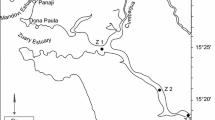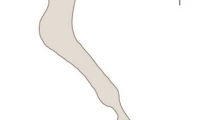Abstract—
Seasonal dynamics of phytoplankton production and structural characteristics was studied at two closely located stations in the open part of the Sevastopol Bay mouth, one of which was a mussel farm. The net primary production, chlorophyll a content, total phytoplankton biomass, the quantitative ratio between small and large algal cells, and their seasonal dynamics were the same for both stations. Linear dependencies were observed between the relevant parameters of the stations, with the angular regression coefficients close to 1. The phytoplankton production and biomass peaked during the summer period, reaching 350 ± 43 mg C/(m3 day) and 450 ± 50 mg C/m3, respectively. Chlorophyll a content varied from 0.5 to 3 mg/m3, with the minimum in January‒February and the maximum in summer. The assimilation number values for chlorophyll a during the light period corresponded to those reported for production waters and correlated with the temperatures during the year. Total oxygen consumption by bacterio- and phytoplankton during the summer period was 30–70% of net photosynthesis. The data were obtained on seasonal biomass variations in three groups of algae (Synechococcus, picoeukaryotic phytoplankton, and nanophytoplanktom); on average, picoalgae constituted 30% of the phytoplankton biomass, with maxima during the winter-spring and summer periods. Bacterioplankton abundance was determined using flow cytometry and the SYBR Green I vital fluorochrome. A positive relation between bacterial abundance and water temperature was shown.







Similar content being viewed by others
REFERENCES
Cranford, P.J., Ward, J.E., and Shumway, S.E., Bivalve filter feeding: variability and limits of the aquaculture biofilter, in Shellfish Aquaculture and the Environment, Shumway, S., Ed., Wiley, 2011, pp. 81‒124. https://doi.org/10.1002/9780470960967.ch4
Demidov, A.B., Seasonal variations of primary production and chlorophyll “a” in the Black Sea open areas, Extended Abstract Cand. Sci. (Biol.) Dissertation, Moscow: Mos. Gos. Univ., 2001.
Dupuy, C., Le Gall, S., Hartmann, H.J., and Bréret, M., Retention of ciliates and flagellates by the oyster Crassostrea gigas in French Atlantic coastal ponds, protists as a trophiclink between bacterioplankton and benthic suspension-feeders, Mar. Ecol. Prog. Ser., 1999, vol. 177, pp. 165–175.
Galkina, V.N., Kulakovskii, E.E., an Kunin, B.L., Effect of mussel aquaculture in the White Sea of the environment, Okeanologiya, 1982, vol. 22, no. 2, pp. 321–324.
Gilbert, F., Souchu, P., Bianchi, M., and Bonin, P., Influence of shellfish farming activities on nitrification, nitrate reduction to ammonium and denitrification at the water-sediment interface of the Thau lagoon, France, Mar. Ecol. Progr. Ser., 1997, vol. 151, pp. 143–153. https://doi.org/10.3354/meps151143
Grant, J., Curran, K.J., Guyondet, T.L., Tita, G., Bacher, C., Koutitonsky, V., and Dowd, M., A box model of carrying capacity for suspended mussel aquaculture in Lagune deGrande-Entrée, Îles-de-la-Madeleine, Québec, Ecol. Model., 2007, vol. 200, pp. 193–206.
Heldal, M., Scanlan, D.J., Norland, S., Thingstad, F., and Mann, N.H., Elemental composition of single cells of various strains of marine Prochlorococcus and Synechococcus using X-ray microanalysis, Limnol. Oceanogr., 2003, vol. 48, pp. 1732–1743. https://doi.org/10.4319/lo.2003.48.5.1732
Jeffrey, S.W. and Humphrey, G.F., New spectrophotometric equations for determining chlorophylls a, b, c 1 and c 2 in higher plants, algae and natural phytoplankton, Biochem. Physiol. Pflanzen., 1975, vol. 167, pp. 191–194. https://doi.org/10.1016/S0015-3796(17)30778-3
Jiang, T., Chen, F., Yu, Z., Lu, L., and Wang, Z., Size-dependent depletion and community disturbance of phytoplankton under intensive oyster mariculture based on HPLC pigment analysis in Daya Bay, South China Sea, Environ. Pollut., 2016, vol. 219, pp. 804‒814.
Kuftarkova, E.A., Eremin, I.Yu., and Subbotin, A.A., Fine vertical chemical water structure inthe mussel farm area (pre-channel part of the Sevastopol Bay), Mor. Ekol. Zh., 2011, vol. 10, no. 1, pp. 38–42.
Kuftarkova, E.A., Gubanov, V.I., Kovrigina, N.P., Eremin, I.Yu., and Senicheva, M.I., Ecological assessment of the present-day state of the water in the area of interaction between the Sevastopol Bay and adjacent part of the sea, Mor. Ekol. Zh., 2006, vol. 5, no. 1, pp. 72–91.
Mirto, S., Danovaro, R., and Mazzola, A., Microbial and meiofaunal response to intensive mussel-farm biodeposition in coastal sediments of the western Mediterranean, Mar. Poll. Bull., 2000, vol. 40, pp. 244–252. https://doi.org/10.1016/S0025-326X(99)00209-X
Mukhanov, V.S., Rylkova, O.A., Churilova, T.Y., Sakhon, E.G., and Pimenov, N.V., Structure and seasonal trophodynamics of picophytoplankton in Sevastopol Bay and adjacent waters (the Black Sea), Microbiology (Moscow), 2016, vol. 85, pp. 553‒561.
Murdoch, R. and Oliver, M., Study of Chlorophyll Concentrations within and Around Mussel Farms: Beatrix Bay, Pelorus Sound, NIWA, Wellington, 1995, 1995/6-WN.
Myslenkov, S.A. and Samsonov, T.E., Investigation of the Blakc Sea shelf currents by GNSS monitoring, Izv. Vyssh. Ucheb. Zav. Geodeziya i Aerofotos’emka, 2014, vol. 3, pp. 60–68.
Officer, G.B., Smayda, T.J., and Mann, R., Benthic filter feeding: a natural eutrophication control, Mar. Ecol. Progr. Ser., 1982, vol. 9, pp. 203–210.
Popov, M.A. and Erokhin, A.V., Currents in the area of the oyster-mussel farm as a factor of optimal mariculture functioning (Sevastopol, Black Sea), Mor. Biol. Zh., 2017, vol. 2, no. 4, pp. 58–66.https://doi.org/10.21072/mbj.2017.02.4.06
Prins, T.C., Smaal, A.C., and Dame, R.F., A review of the feedbacks between bivalvegrazing and ecosystem processes, Aquat. Ecol., 1998, vol. 31, pp. 349–359.
Rauen, T.V., Khanaichenko, A.N., and Mukhanov, V.S., Effect of microalga and their filtrates on bacterial abundance in the environment of turbot growth, Mor. Ekol. Zh., 2011, vol. 10, no. 3, pp. 48–56.
Ryl’kova, O.A., Long-term measurements of bacterioplankton abundance at the Sevastopol coastal area (Black Sea), Mor. Ekol. Zh., 2013, vol. 12, no. 1, pp. 74–79.
Safi, K.A. and Hayden, B., Differential grazing on natural planktonic populations by the mussel Perna canaliculus, Aquat. Biol., 2010, vol. 11, pp. 113‒125.
Safi, K.A., Hewitt, J.E., and Talman, S.G., The effect of high inorganic seston loads on prey selection by the suspension-feeding bivalve, Atrina zelandica, Exp. Mar. Biol. Ecol., 2007, vol. 344, pp. 136‒148.
Senichiva, M.I., Species diversity, seasonal and year-to-year variability of microalgae in the plankton at Crimean coasts, in Mikrovodorosli Chernogo Morya: problemy sokhraneniya bioraznoobraziya i biotekhnologicheskogo ispol’zovaniya (Black Sea Microalgae: Biodiversity Preservation and Biotechnological Application), Tokarev, Yu.N. et al., Eds., Sevastopol: EKOSI-Gidrofizika, 2008, pp. 18–23.
Seregin, S.A., Seasonal and perennial dynamics of the total bacterioplankton abundance in the Sevastopol coastal waters, Ryb. Khoz. Ukrainy, 2013, vol. 2, pp. 10–16.
Shalapenok, L.S. and Shalapenok, A.A., Heterogeneous pigment composition of phycoerythrin-containing picocyanobacteria Synechococcus spp. in the Black Sea, Microbiology (Moscow), 1997, vol. 66, pp. 80–85.
Stel’makh, L.V., Contribution of picoplankton to primary production and chlorophyll a content in eutrophic waters: case of the Sevastopol Bay, Okeanologiya, 1988, vol. 28, no. 1, pp. 127–131.
Steven, D.M., Primary productivity of the tropical western Atlantic Ocean near Barbados, Mar. Biol., 1971, vol. 10, pp. 261–264. https://doi.org/10.1007/BF00352816
Trottet, A. Roy, S., Tamigneaux, E., Lovejoy, C., and Tremblay, R., Impact of suspended mussels (Mytilus edulis L.) on plankton communities in a Magdalen Islands lagoon (Québec, Canada): a mesocosm approach, Exp. Mar. Biol. Ecol., 2008, vol. 365, pp. 103‒115.
Vedernikov, V.I., Seasonal variations in assimilation numbers of marine phytoplankton, Tr. VGBO, 1978, vol. 22, pp. 18–31.
Verity, P.G., Robertson, C.Y., Tronzo, C.R., Andrews, M.G., Nelson, J.R., and Sieracki, M.E., Relationships between cell volume and the carbon and nitrogen content of marine photosynthetic nanoplankton, Limnol. Oceanogr., 1992, vol. 37, pp. 1434–1446. https://doi.org/10.4319/lo.1992.37.7.1434
Vinberg, G.G., Pervichnaya produktsiya vodoemov (Primary Production in Water Bodies), Minsk: RISO AN BSSR, 1960.
Metodika izmereniya iodometricheskim metodom (Volume Concentration of Dissolved Oxygen in Seawater. Procedure for Iodometric Measurement, RD no. 52.10.736-2010, approved 15.11.2010, introduced 2011.07.01), Moscow: Rosgidromet, 2010. URL: https://meganorm.ru/Data2/ 1/4293791/4293791177.htm.
Wetz, M.S., Lewitus, A.J., Koepfler, E.T., and Hayes, K.C., Impact of the eastern oyster Crassostrea virginica on microbial community structure in a salt marsh estuary, Aquat. Microb. Ecol., 2002, vol. 28, pp. 87‒97.
Williams, R.B. and Murdoch, M.B., Phytoplankton production and chlorophyll concentration in the Beaufort channel, North Carolina, Limnol. Oceanogr., 1966, vol. 11, pp. 73–82. https://doi.org/10.4319/lo.1966.11.1.0073
Worden, A.Z., Nolan, J.K., and Palenik, B., Assessing the dynamics and ecology of marine picophytoplankton: the importance of the eukaryotic component, Limnol. Oceanogr., 2004, vol. 49, pp. 168–179. https://doi.org/10.4319/lo.2004.49.1.0168
Zaika, V.E., Shalapenok, L.S., Pokotilov, S.L., Ixmenemie chastoty delyashchikhsya tsianobakterii po glubine i vermeni sutok (Frequency of occurrence of dividing cyanobacteria depending on depth and time of day), Available from VI-NITI, Sevastopol, 1991, no. 870-B91.
Zaika, V.E., Shevchenko, V.A., and Bulatov, K.V., Ekolo-giya morskogo fototrofnogo pikoplanktona (Ecology of Marine Phototrophic Picoplankton), Moscow: NTsBI, 1989.
Zhang, X., Huang, X., and Huang, L., Phytoplankton community structure shaped by key environmental factors in fish and shellfish farms in Daya Bay, South China, Aquatic Ecosystem Health and Management, 2013, vol. 16, no. 3, pp. 300‒310. https://doi.org/10.1080/14634988.2013.817935
Zolotnitskii, A.P. and Kryuchkov, V.G., On the possible ecological consequrnces of large-scale mussel cultivation in the Black Sea shelf zone, in Sovermennye problemy ekologii Azovo-Chernomrskogo basseina (Present-Day Ecological Problems of the Azov-Black Sea Basin), Proc. 2nd Int. Conf., Kercj: YugNIRO, 2006, pp. 30–35.
Funding
The work was carried out within the framework of the State Assignment no. 121041400077-1 “Functional, Metabolic, and Toxicological Aspects of Existence of Hydrobionts and Their Populations in Biotopes with Different Physicochemical Modes”.
Author information
Authors and Affiliations
Corresponding author
Ethics declarations
The authors declare that they have no conflict of interest. This article does not contain any studies involving animals or human participants performed by any of the authors.
Additional information
Translated by P. Sigalevich
Rights and permissions
About this article
Cite this article
Solomonova, E.S., Akimov, A.I. Production and Structural Parameters of the Phytoplankton and Bacterioplankton Communities at Two Stations in the Open Part of the Sevastopol Bay Mouth: Assessment of the Effect of the Mussel Farm. Microbiology 90, 785–792 (2021). https://doi.org/10.1134/S002626172106014X
Received:
Revised:
Accepted:
Published:
Issue Date:
DOI: https://doi.org/10.1134/S002626172106014X




